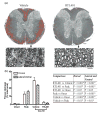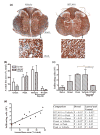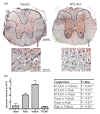Antigen-specific therapy promotes repair of myelin and axonal damage in established EAE
- PMID: 16899071
- PMCID: PMC2175524
- DOI: 10.1111/j.1471-4159.2006.04081.x
Antigen-specific therapy promotes repair of myelin and axonal damage in established EAE
Abstract
Inflammation results in CNS damage in multiple sclerosis (MS) and experimental autoimmune encephalomyelitis (EAE), an animal model of MS. It is uncertain how much repair of injured myelin and axons can occur following highly selective anti-inflammatory therapy in EAE and MS. In this study, SJL/J mice with established EAE were treated successfully with an antigen-specific recombinant T cell receptor ligand (RTL), RTL401, a mouse I-A(s)/PLP-139-151 construct, after the peak of EAE. To define the mechanisms by which late application of RTL401 inhibits EAE, we evaluated mice at different time points to assess the levels of neuroinflammation and myelin and axon damage in their spinal cords. Our results showed that RTL401 administered after the peak of acute EAE induced a marked reduction in inflammation in the CNS, associated with a significant reduction of demyelination, axonal loss and ongoing damage. Electron microscopy showed that RTL-treated mice had reduced pathology compared with mice treated with vehicle and mice at the peak of disease, as demonstrated by a decrease in continued degeneration, increase in remyelinating axons and the presence of an increased number of small, presumably regenerative axonal sprouts. These findings indicate that RTL therapy targeting encephalitogenic T cells may promote CNS neuroregenerative processes.
Figures







References
-
- Arnold DL, Matthews PM, Francis GS, O’Connor J, Antel JP. Proton magnetic resonance spectroscopic imaging for metabolic characterization of demyelinating plaques. Ann Neurol. 1992;31:235–241. - PubMed
-
- Back SA, Tuohy TM, Chen H, Wallingford N, Craig A, Struve J, Luo NL, Banine F, Liu Y, Chang A, Trapp BD, Bebo BF, Jr, Rao MS, Sherman LS. Hyaluronan accumulates in demyelinated lesions and inhibits oligodendrocyte progenitor maturation. Nat Med. 2005;11:966–972. - PubMed
-
- Barkhof F, Bruck W, De Groot CJ, Bergers E, Hulshof S, Geurts J, van Polman CH, van Polman dV. Remyelinated lesions in multiple sclerosis: magnetic resonance image appearance. Arch Neurol. 2003;60:1073–1081. - PubMed
-
- Bruck W. The pathology of multiple sclerosis is the result of focal inflammatory demyelination with axonal damage. J Neurol. 2005;252:v3–v9. - PubMed
-
- Burrows GG, Adlard KL, Bebo BF, Jr, Chang JW, Tenditnyy K, Vandenbark AA, Offner H. Regulation of encephalitogenic T cells with recombinant TCR ligands. J Immunol. 2000;164:6366–6371. - PubMed
Publication types
MeSH terms
Substances
Grants and funding
LinkOut - more resources
Full Text Sources
Other Literature Sources
Molecular Biology Databases
Research Materials

